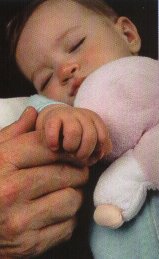| Chapter 9: | Thermoregulation |
 |
The neonate is at highest risk of heat loss shortly after delivery. Thermoregulation is of utmost importance in the care of a newborn. The goal in the delivery room is to maintain an environmental temperature such that the neonate's core temperature remains in the normal range of 36.5 to 37.5°C. For this goal to be achieved, all avenues of heat loss must be minimized or eliminated. The mechanisms of heat loss in the newborn include:
- Evaporation can occur shortly after birth, when the infant
is wet. As the liquid dries and evaporates it takes valuable heat with
it. Immediately after delivery, every newborn should immediately be
completely dried with a prewarmed towel or blanket. The head and face
are particularly important. This drying helps reduce the evaporative
heat loss. Thereafter, the neonate should be kept dry.
- Radiant loss involves the loss of heat from merely being placed
near a cold surface, causing the transfer of heat from the warm baby
to the nearby cooler object. After being dried, the neonate should be
wrapped in a warm blanket and immediately placed beneath a radiant heater
for resuscitation or examinations. Since a tremendous amount of heat
loss can occur from the infant's head, a cap or other covering should
be placed on the baby's head.
- Both convective and conductive loss pose threats to the neonate's thermoregulation. Conduction takes place when the infant is placed on a cold surface which pulls heat away from the baby. Convective heat loss is caused by air turbulence in the room that cools the infant. The neonate should be placed on a warming mattress and kept covered as much as possible to avoid convective heat losses. As quickly as possible, the neonate should be placed in a prewarmed incubator. The longer the baby is left out in the open, the greater the chance of hypothermia.
The goal regarding neonates' thermoregulation is to achieve and maintain a neutral thermal environment (NTE), an environment that allows the infant to maintain their internal temperature without increasing oxygen consumption. Too much or too little heat are both adverse situations that lead to increased 02 consumption and apnea. To maintain that proper temperature:
- a thermistor is placed on the neonate's skin to monitor skin temperature
- the thermistor is connected to a servo control on the heat source
- the servo control then adjusts the heat to maintain the NTE.
Guidelines for setting of NTE are based upon infant age and weight. The following can be used as a general guideline:
WEIGHT
(grams)
| AGE | <12OO | 1200-1500 | 1500-2500 | >2500 |
|
|
(>36wks) | |||
| 0-24 hrs | 34.0-35.4°C | 33.9-34.3°C | 32.8-33.8°C | 32.0-33.7°C |
| 24-96 hrs | 34.0-35.0°C | 33.0-34.2°C | 31.1-33.2°C | 29.8-32.8°C |
| 4-14 days | ---------- | 32.6-34.0°C | 31.0-33.2°C | 29.0-32.6°C |
Having reviewed development of fetal anatomy and physiology, risk factors, monitoring, anticipation, and preparation for problems, it is time to discuss the actual delivery and the first few minutes of extrauterine life.